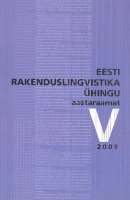Tegumood eesti lapsekeeles
Voice constructions in Estonian child language
Author(s): Reeli Torn-Leesik, Renate Pajusalu , Maigi VijaSubject(s): Language and Literature Studies
Published by: Eesti Rakenduslingvistika Ühing (ERÜ)
Keywords: child language acquisition; input; grammatical categories; impersonal voice; passive voice; Estonian
Summary/Abstract: This article analyses the production and comprehension of Estonian impersonal and passive constructions by Estonian children. The analysis of production involves counting and analysing the occurrence of voice constructions in the interaction between a child (around 1 to 3 years old) and an adult. The material for analysis is drawn from recordings of Estonian children in the CHILDES database. The results showed that impersonal constructions were generally used to express general rules of accepted behaviour. The impersonal was also sometimes used to avoid mentioning the actor. Most verbs in the impersonal were transitive. Periphrastic tud-participle constructions were used to mark resultativity, which was considered as an expression of aspect. The comprehension of Estonian impersonal and passive constructions was tested among 4"6-year-old children. The results of the test show that children have no difficulty in understanding impersonal constructions. Difficulties occur when the agentive poolt-construction (‘by-phrase’) is inserted in an impersonal construction. The test also included active OVS-type sentences. The children found these more difficult, especially when the object lacked an explicit object marker.
Journal: Eesti Rakenduslingvistika Ühingu aastaraamat
- Issue Year: 2009
- Issue No: 5
- Page Range: 329-344
- Page Count: 16
- Language: Estonian

